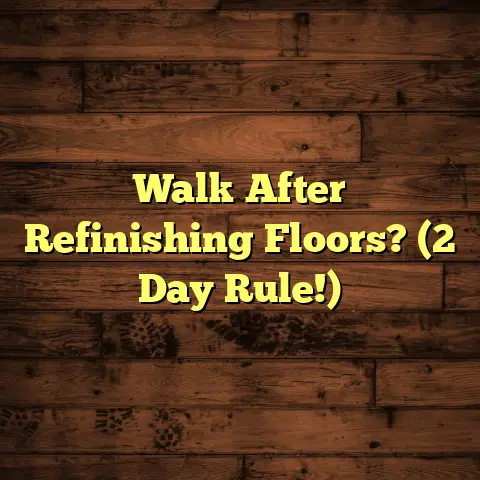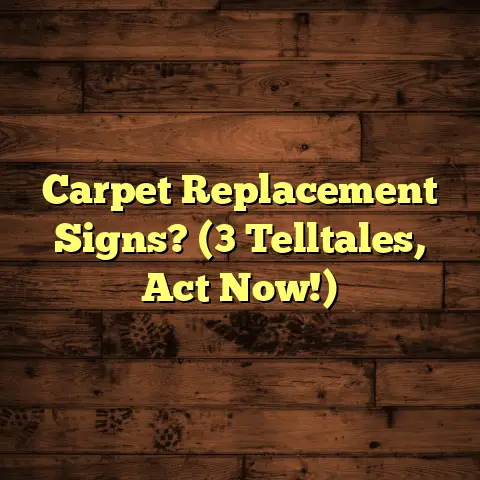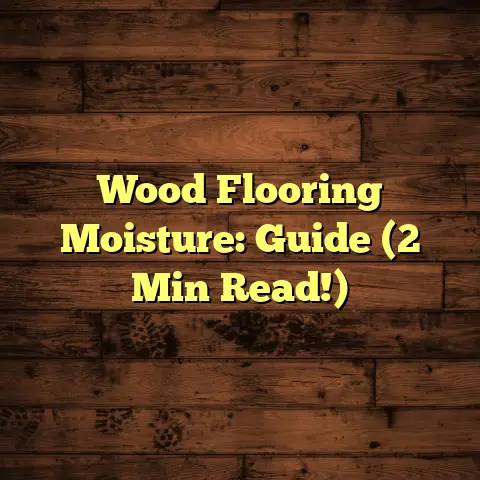Stop Creaky Floors Now! (1 Fix, Before It’s Too Late!)
Ever watch a horror movie where the creaky floorboards are practically screaming “Don’t go in there!”?
Or maybe a comedy where someone tiptoes around, trying to avoid the telltale squeak that gives them away?
Creaky floors are a classic trope for a reason: they tap into something primal in us.
That sense of unease, the feeling that something’s not quite right. But what if I told you those creaks aren’t just movie magic?
They’re a real-life problem, and ignoring them can lead to more than just jump scares.
As a flooring contractor with years under my belt, I’ve seen firsthand the damage that neglected creaks can cause.
It’s not just annoying; it can be a sign of serious structural problems lurking beneath your feet.
So, before your house starts sounding like a haunted mansion, let’s dive into the world of creaky floors and how to silence them, permanently.
Understanding Creaky Floors:
The Anatomy of a Squeak
Okay, let’s get down to brass tacks. Why do floors creak in the first place?
Think of your flooring system like a well-orchestrated team. You’ve got the joists, those sturdy beams that provide the foundation.
Then there’s the subfloor, the plywood or OSB layer that sits on top of the joists.
And finally, the surface material: hardwood, laminate, tile – the stuff you actually walk on.
When everything’s working together perfectly, it’s smooth sailing. But age, humidity, and temperature changes can throw a wrench into the works.
Imagine your joints getting a little stiff as you get older. Same thing happens with your floor.
Wood expands and contracts with moisture, causing it to rub against other materials.
Nails loosen, wood warps, and suddenly, you’ve got a symphony of squeaks every time you take a step.
Here’s a quick breakdown of common causes:
-
Loose Fasteners: Nails or screws holding the subfloor to the joists can work their way loose over time.
-
Friction: Wood rubbing against wood, especially between the subfloor and joists, or between floorboards themselves.
-
Gaps: Gaps between the subfloor and joists create space for movement, leading to creaks.
-
Humidity: Changes in humidity cause wood to expand and contract, exacerbating existing problems.
-
Settling: As a house settles, the framing can shift, causing floors to creak in certain areas.
Did you know that older homes with solid wood floors are particularly prone to creaks?
That’s because they often rely on traditional construction methods that are more susceptible to movement over time.
But don’t think modern homes are immune! Engineered wood and laminate floors can also creak if they’re improperly installed or exposed to excessive moisture.
The key takeaway here is that creaky floors aren’t just a cosmetic issue.
They’re a symptom of something deeper going on within your flooring system.
And like any symptom, ignoring it can lead to bigger problems down the road.
The Consequences of Ignoring Creaky Floors:
More Than Just an Annoyance
Alright, so you’ve got a few creaks. Big deal, right?
Wrong. Let me tell you, ignoring those squeaks can be a recipe for disaster.
Think of it this way: that creak is your floor’s way of saying, “Hey, something’s not right down here!”
It’s a warning sign that shouldn’t be ignored.
One of the biggest dangers of neglecting creaky floors is the potential for underlying structural issues.
Those persistent creaks can indicate loose joists, deteriorating support beams, or even water damage.
And trust me, those are problems you don’t want to mess with.
I remember one case where a homeowner ignored a creaky spot in their kitchen for years.
Turns out, there was a slow leak under the sink that had rotted out the joist beneath the floor.
By the time they finally called me, the damage was extensive, and the repair bill was through the roof.
According to a 2023 report by the National Association of Home Builders, structural repairs can cost anywhere from \$5,000 to \$50,000, depending on the severity of the damage.
That’s a hefty price to pay for ignoring a few squeaks!
But the consequences aren’t just financial. Living with persistent noise can also take a toll on your mental health.
Imagine trying to relax after a long day, only to be constantly interrupted by the sound of creaking floors.
It’s enough to drive anyone crazy!
Studies have shown that noise pollution can lead to stress, anxiety, and even sleep disturbances.
And let’s not forget about the impact on your property value. A house with creaky floors can be a major turnoff for potential buyers.
It creates the impression that the home is poorly maintained or has underlying structural problems.
According to a 2022 survey by Realtor.com, homes with visible defects, such as creaky floors, tend to sell for 5-10% less than comparable properties in good condition.
So, what’s the takeaway here? Ignoring creaky floors isn’t just about putting up with a little annoying noise.
It’s about protecting your investment, preserving your mental health, and preventing potentially costly structural repairs.
Don’t wait until it’s too late. Take action now to silence those squeaks and ensure the long-term stability of your home.
The One Fix: The Ultimate Solution to Creaky Floors
Alright, let’s get to the good stuff. You’re tired of the creaks, and I’m here to help you silence them.
I’m going to walk you through a simple, effective fix that you can do yourself, without breaking the bank or hiring a professional.
This fix focuses on securing loose floorboards and eliminating the friction that causes those annoying creaks.
We’ll be using screws and shims to tighten things up and create a more stable, squeak-free floor.
1. Gathering Materials:
Before we get started, let’s make sure you have everything you need. Here’s a list of essential tools and materials:
-
Screws: Choose screws that are long enough to penetrate the subfloor and reach the joists, but not so long that they poke through the ceiling below. I usually recommend 1 1/4″ to 1 5/8″ screws for most applications. Deck screws or wood screws work great.
-
Drill: You’ll need a drill to drive the screws into the floorboards. A cordless drill is ideal for this project.
-
Drill Bits: You’ll need a drill bit that’s slightly smaller than the diameter of your screws. This will create a pilot hole to prevent the wood from splitting.
-
Shims: Shims are thin, tapered pieces of wood that can be used to fill gaps between the subfloor and joists. You can find them at most hardware stores.
-
Wood Glue: Wood glue can be used to secure the shims in place and further reduce friction.
-
Hammer: A hammer will be used to gently tap the shims into place.
-
Utility Knife: A utility knife is useful for trimming the shims to the correct size.
-
Safety Glasses: Always wear safety glasses when working with power tools to protect your eyes.
-
Earplugs: Drilling can be noisy, so earplugs are a good idea to protect your hearing.
You can find all of these materials at your local hardware store or home improvement center.
2. Locating the Source of the Creak:
This is the most important step in the process. You need to pinpoint the exact location of the creak before you can fix it.
Here’s how to do it:
-
Walk the Floor: Slowly walk across the floor, paying close attention to where the creaks are coming from. Try to isolate the specific boards that are causing the noise.
-
Apply Pressure: Once you’ve identified a potential source of the creak, apply pressure to the board with your hand or foot. See if you can reproduce the noise.
-
Listen Carefully: Pay attention to the type of creak you’re hearing. Is it a high-pitched squeak, or a low-pitched groan? This can give you clues about the cause of the problem.
-
Mark the Spot: Once you’ve located the source of the creak, mark it with a pencil or piece of tape. This will help you keep track of where you need to focus your efforts.
It may take some time and patience to find all the creaky spots, but it’s worth it in the end.
The more accurately you can pinpoint the source of the noise, the more effective your fix will be.
3. Preparing the Area:
Before you start drilling and screwing, it’s important to prepare the area.
Here’s what you need to do:
-
Clear Furniture: Move any furniture or obstacles away from the work area. This will give you plenty of room to move around and work safely.
-
Clean the Floor: Sweep or vacuum the floor to remove any dirt or debris. This will prevent the screws from getting clogged and ensure a clean, smooth surface.
-
Protect the Floor: If you’re working on a delicate floor surface, such as hardwood, consider laying down a drop cloth or protective sheet to prevent scratches or damage.
4. Executing the Fix:
Now for the main event! Here’s how to secure loose floorboards with screws and shims:
-
Drill Pilot Holes: Using your drill and a drill bit that’s slightly smaller than the diameter of your screws, drill pilot holes through the floorboard and into the subfloor. Space the pilot holes about 6-8 inches apart along the length of the creaky board.
-
Drive Screws: Insert the screws into the pilot holes and drive them in until they’re flush with the surface of the floorboard. Be careful not to overtighten the screws, as this could strip the wood.
-
Shim the Gaps: If you notice any gaps between the subfloor and joists, insert shims into the gaps. Gently tap the shims in with a hammer until they’re snug and secure.
-
Trim the Shims: Use a utility knife to trim any excess shim material that’s sticking out from the floor.
-
Apply Wood Glue: If you want to further secure the shims, apply a small amount of wood glue to the shims before inserting them into the gaps.
Tips for Avoiding Common Pitfalls:
-
Don’t Use Too Many Screws: Overdoing it with the screws can actually weaken the floorboards. Use just enough screws to secure the board and eliminate the creak.
-
Be Careful Not to Split the Wood: Drilling pilot holes will help prevent the wood from splitting, but it’s still important to be careful when driving the screws. If you feel the wood starting to split, stop immediately and try a different location.
-
Don’t Overtighten the Screws: Overtightening the screws can strip the wood and make the problem worse. Tighten the screws until they’re snug, but not overly tight.
-
Use the Right Size Shims: Using shims that are too thick can create a bulge in the floor. Use shims that are just the right size to fill the gaps without causing any distortion.
5. Finishing Touches:
Once you’ve secured the floorboards and shimmed the gaps, it’s time for the finishing touches.
Here’s what you need to do:
-
Clean Up: Sweep or vacuum the floor to remove any sawdust or debris.
-
Fill the Screw Holes: If you want to conceal the screw holes, you can fill them with wood filler that matches the color of your floor.
-
Sand Smooth: Once the wood filler is dry, sand it smooth with fine-grit sandpaper.
-
Apply Finish: If you’ve sanded the floor, you may need to apply a new coat of finish to protect the wood.
6. Testing the Fix:
The final step is to test your fix and make sure the creak is gone.
Here’s how to do it:
-
Walk the Floor: Slowly walk across the repaired area, paying close attention to any remaining creaks.
-
Apply Pressure: Apply pressure to the repaired area with your hand or foot. See if you can reproduce the noise.
-
Listen Carefully: Pay attention to any sounds coming from the repaired area. If you still hear a creak, you may need to repeat the process or try a different approach.
If you’ve followed these steps carefully, you should be able to eliminate most, if not all, of the creaks in your floor.
But what if the creaks persist? Don’t worry, there are other options.
If you’re dealing with widespread creaking or structural issues, it may be time to call in a professional.
A qualified flooring contractor can assess the situation and recommend the best course of action.
Conclusion:
Silence the Squeaks and Reclaim Your Home
So, there you have it! A simple, effective fix for creaky floors that you can do yourself.
I know it might seem like a small thing, but silencing those squeaks can make a world of difference in your home.
Think about it: no more jump scares, no more tiptoeing around, just peace and quiet.
And remember, ignoring creaky floors can have serious consequences. From structural damage to mental stress, the risks are simply too great to ignore.
I’ve seen firsthand the positive impact that a quiet, stable floor can have on people’s lives.
It’s not just about aesthetics; it’s about creating a comfortable, safe, and enjoyable living environment.
Take Sarah, for example. She was at her wit’s end with the creaky floors in her old Victorian home.
Every step she took felt like she was announcing her presence to the entire neighborhood.
She tried everything: carpet, rugs, even earplugs! But nothing seemed to work.
Finally, she decided to tackle the problem head-on. She followed the steps I’ve outlined in this article, and to her amazement, it worked!
The creaks were gone, and Sarah could finally relax and enjoy her home without the constant soundtrack of squeaks and groans.
Her story is just one example of the power of taking action. Don’t let creaky floors rob you of your peace of mind.
Take the first step toward a quieter, more stable living environment today.
Grab your tools, gather your materials, and get ready to silence those squeaks once and for all.
Your home will thank you for it!





